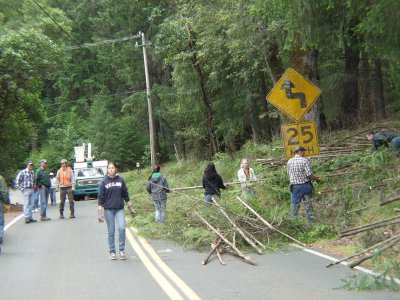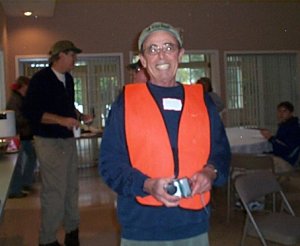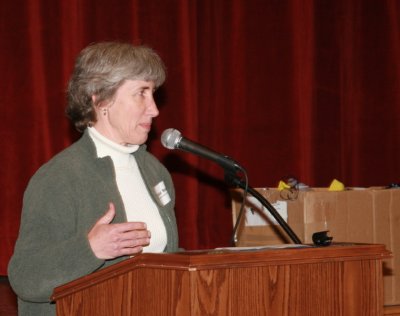LAKEPORT – The case of a young Iraq war veteran making its way through the local courts raises questions about the aftermath of war and how brain injuries may lead to potentially criminal activities in civilian life.
Derick Hughes, 21, of Upper Lake is facing a felony charge of possession of stolen property and a misdemeanor charge of possessing a billy club.
His defense attorneys, Stephen and Angela Carter, have taken the unusual step of speaking publicly about Hughes' case before his sentencing.
The Carters say the circumstances of Hughes' case warrant a deeper consideration of how to deal with people accused of nonviolent criminal charges. As well, they say the case illustrates a looming problem – young vets with brain injuries who may end up in the criminal system.
District Attorney Jon Hopkins would not comment on the case's specifics. “I don't think we can take a final position on the sentencing of Mr. Hughes until the end of the sentencing hearing,” he said.
Hughes was stopped on Dec. 15, 2006, in Nice by Lake County Sheriff's Deputy Tom Andrews. Court documents report that Andrews found Hughes in possession of a bat – classified as a billy club – and two ballistic panels used by the Marines for body army, as well as concentrated cannabis.
Andrews called the Marine post at Twentynine Palms in Southern California where he spoke with the officer of the day, Angela Carter reported. When the officer told Andrews that Hughes should not have the panels, and that they were Marine property, Hughes was charged with possession of stolen property.
Court documents state that Hughes was cooperative with law enforcement officials and admitted occasional drug use.
The Carters say that their defendant's case is colored by his service in the military and his time spent in Iraq, where he saw some of the war's fiercest fighting, and which has left him affected with post traumatic stress disorder (PTSD).
“To me, what's different about this case is his service in Iraq,” said Angela Carter.
Carter said Hughes was raised in Lake County by his grandmother – who died last year – and his aunt. His mother admitted to drug use while pregnant with him.
Hughes enlisted in the Marines because he was drawn by the idea of travel and regular pay, according to court documents. Hughes attended boot camp at Camp Pendleton, completed the School of Infantry and was assigned to Twentynine Palms.
Deployment anxiety
When he found out he was being sent to Iraq, Hughes began smoking marijuana out of anxiety and failed a urine test, Carter said. However, the Marines still sent him to Iraq.
Carter said Hughes has admitted he should not have had the ballistic panels. She said he had them because of fear and the belief that he needed to protect himself.
“He's facing this,” said Carter. “He's not making any attempt to deny what happened.”
While in Iraq, Hughes said he “had to kill various people,” according to court documents. On Dec. 1, 2005, he was involved in the fighting in Fallujah, were 10 of his platoon members were killed by a roadside bomb explosion during a promotion ceremony. An additional 13 platoon members were wounded. A platoon is typically 30 to 50 soldiers.
The incident in Fallujah is the event that triggered Hughes' PTSD, according to Dr. Albert Kastl, the clinical and forensic neuropsychologist the Carters brought in to evaluate Hughes.
Hughes would suffer a dislocated shoulder during his service. When he was sent back stateside, Carter said Hughes suffered severe nightmares. To avoid sleeping, he took methamphetamines. When he once again tested positive for drugs, he was discharged without medical care for his shoulder or counseling, Carter said.
Angela Carter said Hughes has no criminal background, yet is being charged with a felony that could earn him as many as three years in state prison.
After Hughes' initial arrest, he was released on his own recognizance, said Carter. However, she said he became confused about his appointment with the Probation Department and missed it. When he next came to court for a hearing, the judge had him remanded into custody, where Carter said he has remained for nearly two months.
Hughes was due in court for sentencing April 20, but the sentencing was continued until this Friday because Judge Richard Martin was out of town and unavailable to hear the case, Angela Carter said.
Carter said the Probation Department recommended Hughes be sentenced to 280 days in county jail rather than prison.
However, the Carters are asking Martin to consider reducing Hughes' felony charge to a misdemeanor. In their legal argument, the Carters assert that the charge could be construed as a “wobbler,” a charge which could be either a felony or a misdemeanor.
It's a motion the Carters say the District Attorney's Office is opposing.
“I, for the life of me, can't figure out why they want a felony on this guy,” said Carter.
She said individuals are normally charged on felonies based on two things: the value of the property and previous criminal behavior.
Carter said she doesn't know how much the value of the materials, but she said Hughes has no criminal history.
“Clear case” of PTSD
Dr. Kastl, himself a vet, said Carter, believes that Hughes' is a “clear case” of PTSD, and that he would
benefit greatly from treatment. Kastl, she said, found Hughes personable and outgoing.
Kastl will testify about his findings in the case at Hughes' sentencing this week, Carter said.
It's unusual to put experts on the stand at sentencing unless it's a much larger case, like a homicide, said Carter.
“We want to make sure that we really get our points across,” Carter said. “We want Derick to explain what he went through in Iraq.”
Young vets coming home struggle with transitions
Bob Penny, the assistant service officer at the Lake County Veterans Services Office, said his office is seeing many young vets coming home from war seeking various kinds of help, including counseling. Right now, he said, he's working with 12 young vets locally.
There are many young Lake County natives service in Iraq and Afghanistan right now, Penny said, referring to the Wall of Honor featuring local servicemen and women in the courthouse in Lakeport.
Those returning vets are having problems adjusting to civilian life, said Penny, especially if they've served more than one tour of duty. “That takes a toll on you psychologically,” he said.
Because of the difficulty in adjusting, Penny said, young vets have more of a propensity for getting into trouble. He said the state legislature passed a law last year to try to address that issue and keep them out of the courts.
When they leave active service, Penny said, veterans aren't getting “nearly enough” counseling and help, a responsibility that has been handed over to the Veterans Administration.
A Government Accountability Office report from last year showed that the Veterans Administration budget was flawed, and that the agency had no plan for treating veterans returning from Iraq and Afghanistan.
Studying the war's impact
Whether a person does or doesn't agree with the Carters' arguments in Hughes' defense, the issue of a growing number of young vets returning to U.S. shores with PTSD is a looming social issue.
A report released last August says the numbers of vets suffering from PTSD, which is considered a brain injury, is growing dramatically.
Last year, the Veterans Health Administration's Office of Public Health and Environmental Hazards studied Veterans Administration services sought by veterans of Operations Iraqi Freedom and Enduring Freedom.
Of the 588,923 veterans who had left active duty at that time, 31 percent – or 184,524 – had sought VA health care since 2002.
Of those vets, an estimated 63,767 were diagnosed with possible mental disorders, which include PTSD by definition.
And, finally, 29,041 of those vets were diagnosed with PTSD specifically, with more than 20,095 others diagnosed with depressive disorders; 10,573 with affective psychoses; 4,566 with alcohol dependence; 2,020 with drug dependence; and 2,004 with “acute reaction to stress.”
The Veterans Health Administration Web site features a paper by Brett T. Litz of the National Center for PTSD called “A Brief Primer on the Mental Health Impact of the Wars in Afghanistan and Iraq.”
“The wars in Afghanistan and Iraq are the most sustained combat operations since the Vietnam War, and initial signs imply that these ongoing wars are likely to produce a new generation of veterans with chronic mental health problems associated with participation in combat,” writes Litz.
Litz cites a 2004 study that examined the mental health impact of the wars in Afghanistan and Iraq and found that the risk of PTSD for the Iraq War was 18 percent – a rate he called “alarmingly high” – versus 11 percent for service in Afghanistan.
In fact, that 18 percent rate of PTSD among vets who have served in Afghanistan and Iraq is three percent higher than the estimated prevalence among Vietnam veterans, according to the 1988 National Vietnam Veterans Readjustment Study.
“Many studies indicate that more frequent and more intense involvement in combat operations increases the risk of developing chronic PTSD and associated mental health problems,” Litz wrote. “Initial evidence indicates that combat operations in Iraq are very intense.”
Litz said the study notes that PTSD rates will decrease over time unless “the mission is experienced as a failure, if soldiers deploy more than once, if new veterans who need services do not get the support they need, or if post-deployment demands and stressors mount, the lasting mental health toll of the wars in Afghanistan and Iraq may increase over time.”
Young veterans coming home also appear reluctant to ask for help, according to Litz. Of the 80 percent of soldiers who acknowledged they had a mental health problem, only 40 percent were open to receiving help and 26 percent reported receiving formal mental health care, due to the fear of stigma and its possible effects on their careers.
How will the system deal with young veterans?
There are no hard numbers yet for young veterans who become subject to criminal prosecution.
Although Hopkins would not comment on Hughes' case, he said that, generally, his office would deal with such individuals “on a case by case basis.”
“There are some war vets who present a danger to the community, and some who just need some help,” he said. “Most of those who need help and have committed a crime should be on supervised probation to get the maximum benefit we can offer. There are some who do not need the supervised probation, of course, and we find other ways to assure they will not repeat their crimes.”
Hopkins added, “The crucial issue, in the final analysis, is to determine what needs to be done to protect the community. How a person got to where they are committing crimes can be different when dealing with a war veteran, and that is taken into consideration, but we make the same determination for the resolution of the case as with anyone else. There are often more services available for veterans, and those are utilized as much as possible.”
For her part, Carter said she believes the case will test the idea of “supporting the troops” beyond just their service in war, but after they return home.
Derick Hughes will be in Lake County Superior Court in Lakeport at 9 a.m. Friday, April 27.
E-mail Elizabeth Larson at This email address is being protected from spambots. You need JavaScript enabled to view it..
{mos_sb_discuss:2}

 How to resolve AdBlock issue?
How to resolve AdBlock issue? 












